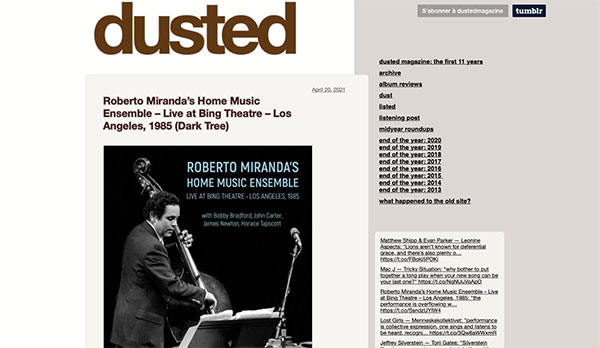• Derek Taylor // Dusted (20 avril 2021)
Auspicious and affirmational, Live at Bing Theatre – Los Angeles, 1985 documents a particularly momentous occasion in bassist/conguero Roberto Miranda’s life. The concert constituted the culmination of his academic studies at the University of Southern California and served as the public performance of his Master’s Recital. Miranda financed the ambitious venture with a precedent-setting grant from the National Endowment of Arts. He was committed to populating his ensemble with a dream assemblage of faculty peers, jazz icons and perhaps most importantly, family. The results were professionally recorded and stand out now thirty-six-years later as something of a perfect convergence of musicians, material and marshalled inspiration.
Miranda’s program presents a series of dynamic originals that unfold in suite-like succession. “Platform for Freedom” immediately favors the rhythm section, specifically the racing give and take between leader and Horace Tapscott. The pianist puts the recital hall instrument through a dizzying set of paces with Miranda’s accelerated pizzicato meeting him blow for blow. Tapscott was the bassist’s employer and mentor and the rapport shaped from copious gigs together is on detailed display prior to a drum kit finale by Miranda’s older brother Louis. “Faith” takes shape around colorful charts advanced by the collective air power of the horns, which include Bobby Bradford, John Carter, James Newton and the chair of the USC Jazz Studies program, Thom David Mason.
“Agony in the Garden” spotlights the percussion section featuring Miranda, his brother, and his father, Louis Sr. along with Elias “Buddy” Toscano and Cliff Brooks augmenting drum kit with a phalanx of congas, bongos and timbales. The percussionists carry over into the opening strains of “Prayer #1,” which sprawls with purpose across a quarter of an hour. Bobby Bradford’s bold brass guides the horns through the oceanic ensemble patterns and the piece takes on the grandeur of an ancient processional with the extra aerial heft of James Newton’s acrobatic flute. Powerful swells and rests alternate, beautifully framed by soloists, advancing and receding currents of percussion and Tapscott’s solemnly sonant keys.
The extended ballad “Deborah Tasmin” is nearly as enterprising in scope and implementation. Hefting tenor sax, Mason alternates with Newton and Carter in the tempered exploration of the leader’s sensuous motifs. Miranda adds commentary on resonant strings and the performance is overflowing with soulful and voluptuous interplay that eventually adds the craggy electric guitar and bass of David Bottenbley. An amplified bass solo and a final call and response percussion piece “Dance of Blessing, Happiness & Peace” complete the set with ardent audience applause peppered between. Miranda’s still active as an educator and performer, but this memorable milestone remains an earlier career peak. overflowing with soulful and voluptuous interplay that eventually adds the craggy electric guitar and bass of David Bottenbley. An amplified bass solo and a final call and response percussion piece “Dance of Blessing, Happiness & Peace” complete the set with ardent audience applause peppered between. Miranda’s still active as an educator and performer, but this memorable milestone remains an earlier career peak.
• • • • • • • • • • • • • • • • • • • • • • • • • • • • • • • • • • • • • • • • • • • • • • • • • • • • • • • • • • • • • • • •

Sorry, the comment form is closed at this time.